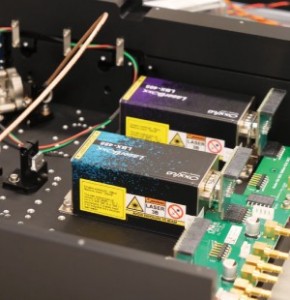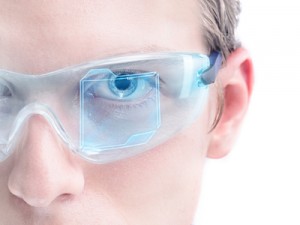
Virtual reality. Augmented reality. Mixed reality. What's the difference, and how do optical coatings fit in? Here we'll explore the specific optical coatings that may be used in this emerging technology, and some of the challenges they must overcome.
As our lives become increasingly digital, technology is keeping pace to blur the lines between the digital and physical world even further. Virtual reality is finally within reach, thanks to advances in smartphones, graphics cards, software, and engineering. It has also spawned offshoots in the form of augmented and mixed reality which are poised to become even more popular.
Virtual reality (VR) immerses the user in another world, tricking the brain into perceiving the viewed world is real. The viewer wears a heads up display (HUD) or head mounted display (HMD) to block the external world and place the user in a virtual environment (VE). This illusion is tenuous, as aberrations, lag, or reduced field of view caused by the headset can be easily detected by the human brain.
Augmented reality (AR) blends the digital world with the real one through overlays of images or information on our view of the external world. This may come in the form of information or a simulated screen produced via glasses worn by the user, or it can be delivered by viewing the world through a smartphone camera and seeing computer-generated items overlaid on screen.
Mixed reality (MR) takes this one step further, allowing the user to interact with the software-generated images. These objects are anchored in space, and change in size and perspective as the viewer moves. In the hybrid world of mixed reality, synthetic objects react to a user’s actions or physical objects in the background in real time.
Applications of these three technologies include video games, entertainment, psychology research, clinical therapies, engineering, and design. They also have tremendous potential for the training of medical professionals, first responders, pilots, and military personnel. In industry, AR could allow information to be delivered hands-free to workers performing critical functions.
Challenges in hardware
One of the biggest hurdles the field faces is in hardware design, as this is critical to optimizing the user experience. HUDs must deliver realistic visuals at an accessible price, while still being lightweight and comfortable enough for prolonged wear. The human eye has a 180° field of view, 90-110° of which can be replicated by current VR systems, depending on model. What does this mean for the optics used? They need to be plastic or polymer to reduce weight, with coatings that are intelligently engineered to minimize cost while still delivering high performance, often at high cone half angle (CHA) to maintain the needed field of view.
Virtual reality headsets work on the same principle as 3D glasses, combining two slightly different images to give the appearance of depth. Lenses placed between the display and each eye angle the 2D images relative to each other to create a stereoscopic effect. Advanced headsets include head-tracking systems to detect when the user is “looking” somewhere else in the virtual environment and adjust the image. Optical head-tracking systems may use lasers or other light sources to determine a user’s position or movement via reflections from the environment, depending on the approach used. AR glasses, in contrast, often use prisms or beamsplitters to combine the computer-generated images with transmitted light from the real world. Both types of headsets require anti-reflective coatings that preserve color balance and maximize transmission.
AR coatings
In order to maximize delivery of light to the eye, it is important that all optical surfaces be coated to reduce reflectivity for visible light, typically from 400-700 nm. The optics may be flat or curved, and are often irregular in shape. This challenge requires multi-axis coating capability to achieve uniform deposition across an optical surface and throughout a full coating run, which can be challenging for unusually shaped parts.
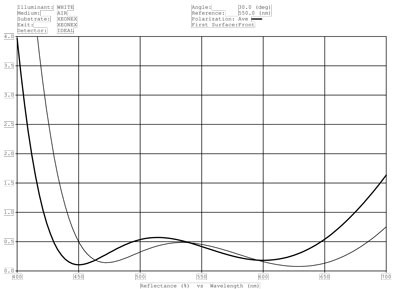
Broadband visible AR coating on Xeonex polymer, 0 & 30 deg AOI, courtesy of AccuCoat inc.
The anti-reflective coatings used in VR and AR headsets often require large cone half angle (CHA); 0-30° from normal is typical, but up to 45° may be needed in some cases. This may require a tradeoff between reflectivity and CHA in the design when coating on plastic or polymer optics, particularly for broadband operation. If so, it can help to consider the light distribution itself. Where is the majority of your light – at what angles? Knowing this, one option is to design for a narrower CHA range, while predicting the performance at higher angles. AR coatings can also be designed for use off-axis (i.e. with a primary angle of operation ranging from 20-40°), spanning that central angle with the true CHA needed for operation.
Given that the required coatings are often the external surface in headsets, durability is extremely important, particularly in industrial or military applications. The cleaning and deposition process used in these coatings must therefore meet the most stringent environmental and durability testing requirements, including a variety of MIL-SPEC and ISO standards – in fact, it can be beneficial to work with a coating supplier with experience in military applications.
Beamsplitters
Beamsplitters are used in headsets to divide the display light for routing to each eye. To reduce the initial intensities needed and maximize battery life, these coating designs and materials should offer low scatter and high efficiency. Splitting ratios may vary from a few percent to 50/50 in VR and AR applications, and are typically specified for average polarization over the visible range.
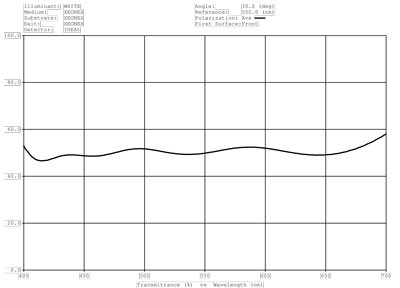
Broadband visible beamsplitter coating on Xeonex polymer, 30° AOI, courtesy of AccuCoat inc.
The causes the colors in a VR display to be skewed between the two channels. It is therefore key to optimize coating designs for uniform efficiency in each channel across the wavelength range at the required CHA, which may require a variety of coating technologies to find the best fit for each application.
Metal coatings
Mirrors are often used for routing of light within headsets, at angles ranging from 30° to 60°.
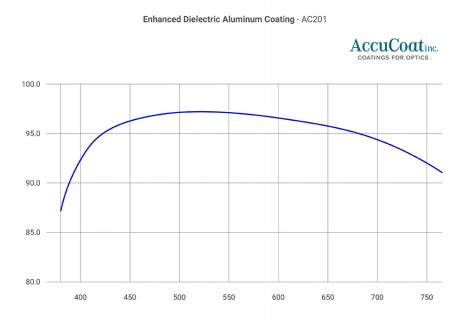
Enhanced dielectric aluminum mirror coating, courtesy of AccuCoat inc.
These reflectors are generally coated with enhanced aluminum or silver, which offer excellent reflectivity, protection against oxidation, and moderate mechanical resistance. A wide variety of tooling fixtures may be needed to accommodate the variety of substrates used for reflectors, from flats to curved surfaces used for focusing and beam shaping.
The reality of optical coatings for VR/AR/MR
As with any new technology, as the performance hurdles are cleared, the next goal is to reduce size and weight. Components used in heads up displays for virtual reality are now getting smaller and smaller, increasing the challenges of cleaning & handling the optics involved. One solution is to start with optics molded with integrated handling pieces, allowing multiple surfaces to be coated on the same tiny optic, after which the handling piece can be cut off.
Custom fixtures to hold smaller parts are often required, and cleaning and coating processes may need to be adjusted to navigate the fine features involved. This is particularly important for curved and irregularly shaped optics if excellent coating uniformity is to be achieved on every run, whether quick turn prototyping or volume production.
As with many industries, the needs of VR, AR, and mixed reality technology are varied and constantly evolving. As players in this burgeoning market seek to find their niche, it can help tremendously to work with a coating provider with the experience, processes, and equipment to adapt and deliver high quality solutions with dependable performance. And that’s just being realistic.
Written by Alan Parsons, Patrick Iulianello, AccuCoat Inc.































 Back to Features
Back to Features











